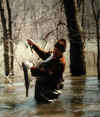| 2-7-05
Any kind of bass fishing tends to flip my cork, but late-winter and
early-spring high-water fishing is very close to the top of my list of
favorites.
This kind of fishing seldom is fast-action stuff, nor is it conducive
to being comfortable. But if one is dressed for the occasion, and the bass
offer occasional action, it can translate into an exciting day.
When the reservoirs are far above normal levels, bass come out into
the inundated brush along shore lines to feed as their inner time clocks
tell them spring is nigh.
The angler who wades the shallow, brush and weed-infested water--or
scrambles along the shore--can flip weedless lures into the heavy cover
to find action. Floating such waters also will produce good results at
times, but I prefer wading (with hip boots or chest-high waders) because
this method, though a bit dangerous, eliminates the necessity of fighting
wind drift of a boat.
I like a black, Johnson spoon with 20-tail black/yellow Hawaiian Wiggler
skirt (reversed), but any lure may take bass. I like black and yellow because
it seems to me that they are more visible in murky/muddy water which prevails
in high-water conditions.
Although all of Indiana’s flood-control reservoirs are above pool stage
now, conditions are not ideal for this kind of fishing because these waters
are being drawn down to make room for more rainwater.
Bass range into inundated areas of brush and weeds because such areas
offers food, a necessity when water temperatures rise and the urge to spawn
grows stronger. But just as bass tend to follow the water line when reservoirs
are rising, they also retreat when water levels are falling.
As noted above, wading under high-water conditions can be dangerous.
Thus, it is wise to use a strong wading staff to check the bottom before
every step.
Just as Monroe Reservoir has been my favorite bass-fishing hole for
many years, it also is my favorite for high-water bass fishing. And my
favorite spot is the Jones Branch bay south and west of the site of the
old Browning Bridge (it has been down for many years).
This large area of flooded hillsides is accessible by motoring in with
a small boat from the Crooked Creek ramp (south of Belmont off Ind. 46)
or by parking a car and walking in from Robinson Cemetery to the south.
For several years after Browning Bridge collapsed it was possible to
drive in on the Elkinsville Road from Robinson Cemetery, but Rex
Watters, fish and wildlife manager at Monroe, says the road now is impassible
even with four-wheel drive. But even if the road still were passable, it
would be covered by water when fishing conditions are right. Thus, to follow
the old road in is next to a three-mile hike.
I almost always opted for the walk with knee boots and chest waders
in a backpack. If water on the roadbed was too deep for knee boots, I made
a quick change to the waders or took to the hills.
Once at the site of the old bridge, I would don my waders and (with
spinning gear (strong line) and an assortment of artificial lures, fish
brush and weeds along the shoreline.
On the late-winter day that I discovered this kind of bassing, I was
wading shallow water along a wooded hillside when I approached a pair of
dead elm trees covered with a curtain of grapevines. I couldn’t remember
why, but the place looked very familiar. The place looked terribly bassy,
too, so I was fishing it hard.
My efforts were rewarded with a lunker that must have weighed close
to seven pounds and two bass of 14 to 16 inches.
Later my faulty cerebellum would tell me the familiarity of the brace
of vine-covered elms stemmed from the fact that I had flushed a pair of
grouse there in the previous fall.
Click on thumbnail
image for enlarged view.
 |
Bayou
Bill hefts a husky largemouth from the murky water of Monroe Reservoir.
|
LEGISLATIVE WATCH--House Joint Resolution
(HJR) No. 4, the so-called right to fish and hunt measure, passed the House
of Representatives by a vote of 83-15 on January 25, 2005. It now is under
consideration by the Senate. To be effective, Rep. John Ulmer’s resolution
would have to pass two sessions of the Indiana General Assembly and be
ratified by state voters.
|

